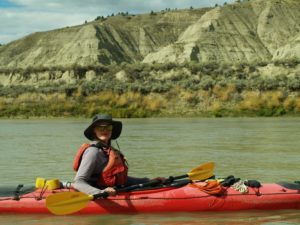 Perched on a cliff, overlooking the Missouri River and surrounding plains, I was confronted by the expansiveness of this place. The vast open space was overwhelming and made me feel small, much like the towering North Woods and Great Lakes do back home in Wisconsin. From up there, at the top of Hole-in-the-Wall, I felt humbled, catching a glimpse of myself as being inseparable from my surroundings, embedded in the landscape. This connection, this sense of place, has been an overarching theme and topic of discussion during my time here in Montana.
Perched on a cliff, overlooking the Missouri River and surrounding plains, I was confronted by the expansiveness of this place. The vast open space was overwhelming and made me feel small, much like the towering North Woods and Great Lakes do back home in Wisconsin. From up there, at the top of Hole-in-the-Wall, I felt humbled, catching a glimpse of myself as being inseparable from my surroundings, embedded in the landscape. This connection, this sense of place, has been an overarching theme and topic of discussion during my time here in Montana.
For the past month and a half I have been traveling through the state, afoot and afloat, on an academic and expeditionary course, with a group from the Wild Rockies Field Institute. When the course comes to an end in just a few short weeks, we will each be tasked with formulating a personal land ethic. So far, through readings, class discussions, time in the field, and meetings with Montana locals and Native tribes, I have become increasingly familiar with the landscape, and have been exposed to many different opinions regarding our human place in and with the natural, nonhuman world. Most striking to me has been the idea that in our modern culture, connecting with nature is a choice.
Dominant Western culture views us, humans, as separate from nature. The nonhuman world, above all else, is seen as a resource, something from which we seek value. Nature is approached with an attitude of domination rather than cooperation. We establish boundaries by designating certain areas as economically valuable, to be used for resource extraction and tourism, others as socially valuable, to be used for recreation and solitude, and others as waste, to become, among other things, landfills. On the whole, nature is valued in terms of what can be gained from it not for being just what it is. By fragmenting bioregions and assigning specific uses to different areas we further divide ourselves from the natural world, making our inherent connection increasingly indecipherable.
In an article we discussed in class, The Ecological Crisis as a Crisis of Character, Wendell Berry explains that in the past few hundred years, individuals have become less and less directly dependent on the natural world for survival; cultural connection to nature has diminished in correlation with the specialization of jobs and roles in society. Berry identifies that loss of connection as a, “crisis of character.” Because individuals no longer have to understand their surroundings in order to meet their basic needs, establishing and maintaining any sort of relationship to nature has become a choice, and unfortunately, not a popular one. There was, however, a time when humans lived with the land rather than off of the land. One Native Blackfeet, Power Buffalo, who spoke to our group back in September, shared it was the belief of his elders that, “We (humans) are part of the land, and the land is part of us.” However out of favor in our modern culture, that view of human and land connection has not been lost entirely. Many recognize that, as author Karen Warren concisely stated in a piece on ecofeminism, “difference does not breed domination”; we are different than nonhuman nature, but those differences do not make us better, and certainly should not allow us to feel dominant.
From what I’ve gathered, seeking out a relationship with the nonhuman world is important because it allows individuals to not only feel connected to nature, but to feel increasingly connected to each other; it fosters attentiveness and curiosity, which, in time, results in understanding and an ensuing love and reverence for the natural world around us. My experiences here in Montana have allowed me to explore and expand my connection to the nonhuman world. From the top of Hole in the Wall, from the peak of a mountain pass, from the center of an expansive prairie, or from a tiny campsite under the big starry sky, it’s impossible, at least for me, to feel greater than this place.